Pawscessories is reader-supported. When you buy via links on our site, we may earn an affiliate commission at no cost to you.
Learn more.
Is your house beginning to smell like urine since your dog won’t stop peeing inside?
Well, luckily there are some easy ways to get your dog to stop peeing inside regardless of their age.
In this article we discuss:
- The 8 reasons dogs pee inside
- 12 tips to get your dog to stop peeing inside
- How to get male dogs to stop peeing on everything
- And other frequently asked question about how to get dogs to stop peeing inside
Let’s get right to it.
Table of Contents
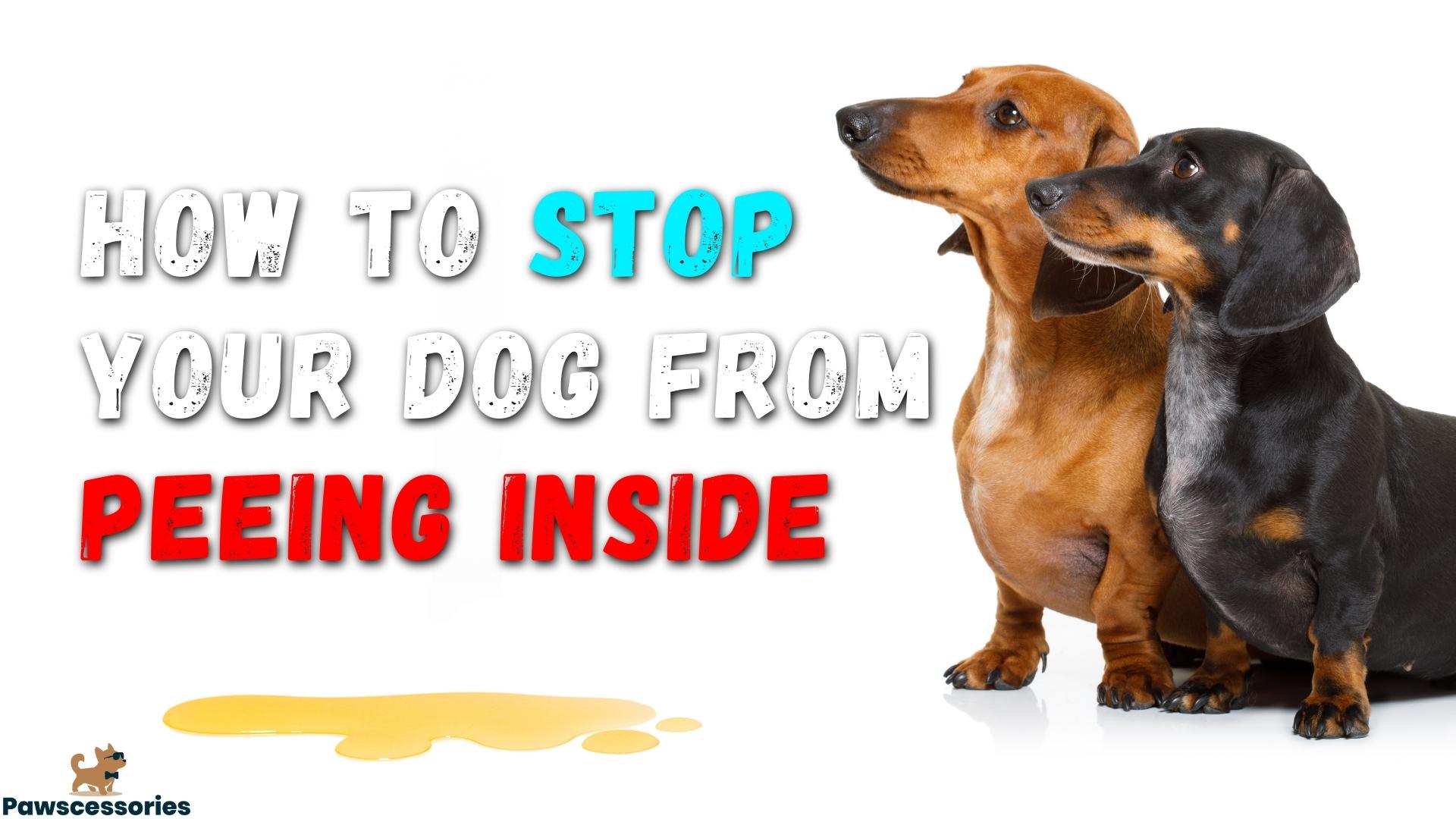
Why Does My Dog Keep Peeing In The House?
In order to fully understand how to stop your dog from peeing inside, we must first understand exactly why they might be peeing.
Dogs pee inside primarily because of improper training. However, there are a number of other reasons dogs pee inside like old age, incontinence, behavioral, and other medical conditions.
Let’s look into each of the reasons dogs pee in more detail.
1.) Not Properly Trained
The number one reason dogs pee inside is from improper training. Puppies need guidance, structure, and routine.
Dogs that are not properly potty trained can develop habits of peeing inside. This makes training even hard since you first have to un-train a habit before developing a new one.
2.) Not Let Outside Enough
Some dogs can hold their bladder better than others. When a dog needs out to pee but no one is around they will end up peeing inside.
The more this occurs the more likely it will develop into a habit.
3.) Incontinence & Medical Issue
Senior dogs can develop what’s called urinary incontinence. This means your dog has lost the ability to fully control their bladder and/or bowels.
This can also develop in younger adult dogs. If you notice your dog is leaving urine puddles in their bed or on your floors, incontinence could be the issue.
In addition to your dog forgetting how to control their bladder, there are several other medical conditions that could be causing house urination.
Here is a list of possible medical conditions that can cause your dog to pee in the house:
- Diabetes
- Infected bladder
- Bladder stones
- Kidney or liver disease
- Tumors
- Cushing’s or Addison’s disease
- Adrenal gland issue
- Intestinal parasites
- Cognitive problems (brain disease or dementia)
- Age-related illness and conditions
4.) Anxiety
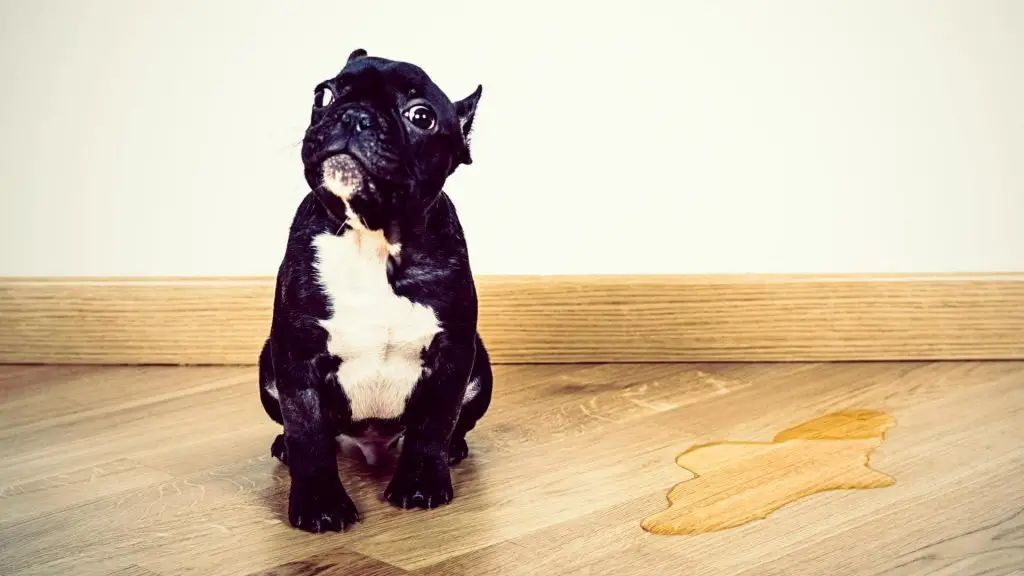
Sometimes dogs develop forms of anxiety that can cause them to pee inside. For example, some dogs with separation anxiety may frequently pee inside while you’re gone.
In addition, there are other forms of anxiety that make dogs nervous, anxious, or overly excited. This can cause dogs of all ages to pee inside.
They might be reacting to anxiety provoked by loud noises, voices, music, etc.
5.) Pee Not Cleaned Properly
When a dog marks their territory they leave behind their scent. This lets them know they have claimed the spot and it is theirs now.
When a dog pees inside and it is just wiped up with water, the pee scent is left behind.
This indicates to the dog, ‘this is my spot’ so they will continue to pee here.
6.) Marking Territory
Dogs mark their territory with their pee and the higher the number of sex hormones the more prominent this behavior.
When dogs are looking for mates they will mark their territory more intensely. Thus, the longer your dog goes without being ‘fixed’ the more difficult it is to train them not to mark in your house.
Plus, if your dog builds this into a habit it can sometimes remain even after your dog gets fixed.
7.) Aging Dog
Puppies will have accidents because they are untrained and unaware of how to pee outside. In contrast, older dogs can develop a form of dementia or senility which can lead to house soiling.
In aging dogs, they can simply forget their house training or forget where they are. Furthermore, as dogs get older they become more susceptible to other health issues, such as kidney failure.
8.) Behavioral Response
If your vet has ruled out health problems and nothing else seems to be causing them to pee in the house, it could be behavioral.
Some male dogs like to mark their territory. This is often driven by hormones but can become habitual even after they have been ‘fixed’.
Another behavioral response your dog might be portraying is excitement or submissive urination. This can happen from your dog feeling stressed, anxious, or intimidated by someone or something.
How To Get Dogs To Stop Peeing Inside (12 Easy Steps)
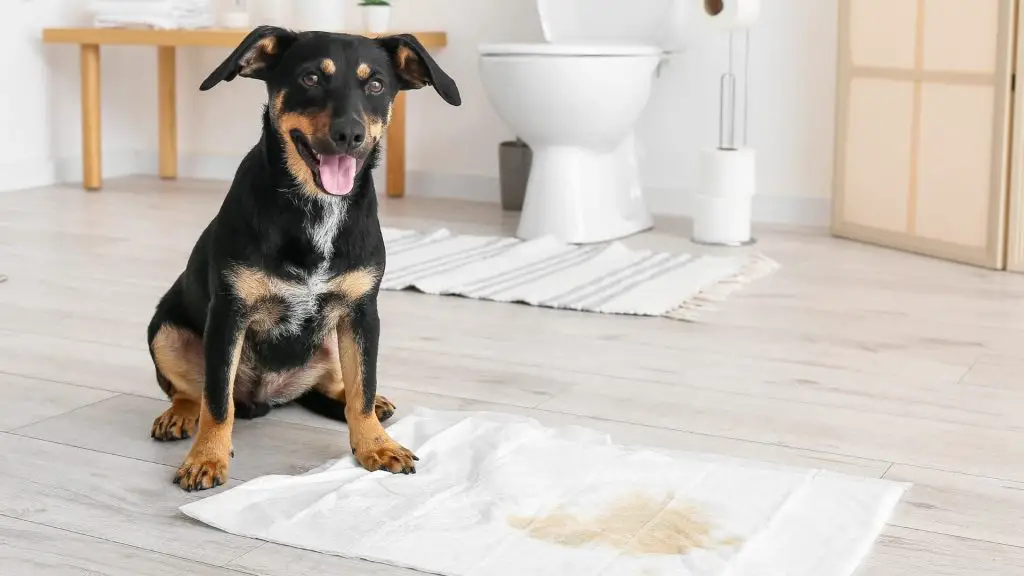
To get your dog to stop peeing inside you need to first determine your dog’s signals and track their potty habits. Once you have an idea of their potty frequency and signals you can set a potty training schedule to get them peeing outside.
Here is a quick overview of how to prevent dogs from peeing in the house:
- Find Out Why They Are Peeing
- Figure Out Your Dogs Signals
- Get a Potty Schedule In Place
- Identify & Eliminate Triggers
- Clean Up Accidents Properly
- Spay or Neuter Your Dog
- Watch Them Like A Hawk
- Don’t Punish Them
- Adjust Water Availability
- Monitor Water Intake
- Avoid Pee Pads
- Get Professional Help
1.) Find Out Why They Are Peeing
The first step in stopping your dog from peeing inside your home is to identify which reasons are causing your dog to pee in the house.
Identify the reason:
- Not properly trained
- Not let outside enough
- Incontinence or medical
- Anxiety
- Marking territory
- Aging dog
- Behavioral habit
- Pee not being properly cleaned
2.) Figure Out Your Dogs Signals
When potty training a puppy under 3 months old, they will not give any signs. They have no motor controls of their bladder to hold it in.
When they have to go, they go. Over time as they age you will start to pick up on their signs.
And those of you with older dogs, most will give a ‘tell’ indicating they are about to or need to pee. It can be a number of things such as:
- Sniffing around or going off on their own
- Walking towards the door
- Smacking the door
- Whining at you
- Overly excited
- Butt wiggle
The list goes on. Every dog is a little different so learn your dog’s unique cues.
Quick note, even with some dogs giving signs you should never sit around waiting for them. Sometimes there will not be any, so you still need a routine in place (tip #3).
3.) Get a Potty Schedule In Place
One of the best ways to get your dog peeing consistently outside is to create a schedule. Whenever they eat a meal, wake up from a nap, or sleep, take them out to pee.
A schedule will help build a habit for your dog, even if your dog does not go pee or poop when you take them out.
The last thing you want to do is wait until your dog ‘tells’ you they have to go. Instead, take them out at the same times every day and encourage them to pee and poop.
Another tip is to track their potty habits. Once you find a pattern or trend in how frequent they go you can adapt.
You may need to increase potty breaks in your schedule to make sure they get outside before peeing.
4.) Identify & Eliminate Triggers
Most dogs have some sort of trigger that will cause them to pee. This can be from drinking water, getting excited you are home, waking up from a nap, etc.
Every dog is a little different. If you can identify the triggers that get them urinating, you can eliminate the trigger or react accordingly.
For example, if you know your dog pees after they drink water, you can take them out immediately after.
Other triggers that are more difficult to eliminate might be ones related to anxiety. Certain dogs may be easily scared which can cause them to pee.
To handle this you need to desensitize your dog to loud noises and build their confidence.
In addition, dogs with separation anxiety may cause them to pee when they are not home.
When it comes to anxiety or any other health-related triggers it’s best to consult a vet to get the best possible solution to help.
5.) Clean Up Accidents Properly
A Classic mistake many dog owners make is cleaning up urine with water. This leaves behind your dog’s urine scent.
If they can smell it, they are more likely to urine again in the same spot or nearby. It’s the same reason dogs pee in the same areas on their walks.
Make sure to use a scent spray when cleaning up your dog’s pee. They will help to eliminate the smell and help prevent them from peeing there again.
Here are the best ones you can get on Amazon:
- Resolve Urine Destroyer Spray Stain & Odor Remover
- Resolve Ultra Pet Stain & Odor Remover Spray
- Simple Solution Extreme Pet Stain and Odor Remover
6.) Spay or Neuter Your Dog
A frequent question that pops up is “will neutering stop a dog from peeing in the house?”. The answer is, it actually can stop them.
Some dogs are peeing in the house to mark their territory and the more sex hormones the more likely they are to do this.
If your dog is between 5-12 months of age and not ‘fixed’ your dog might be marking their territory.
Getting them ‘fixed’ might be the solution you are looking for to stop them from peeing inside.
7.) Watch Them Like A Hawk
If you want to prevent your dog from peeing inside the best way to do this is by watching them and restricting their freedom.
If your dog starts to sniff around or show signs they are going to pee the more closely you are watching the earlier you can catch them.
Timing is everything when getting your dog to pee outside. If you can catch them right before they pee and bring them outside it will be easier to train them.
Another great tip is to restrict their freedom with a gate or pen that can restrict them to one certain area in your home.
8.) Don’t Punish Them
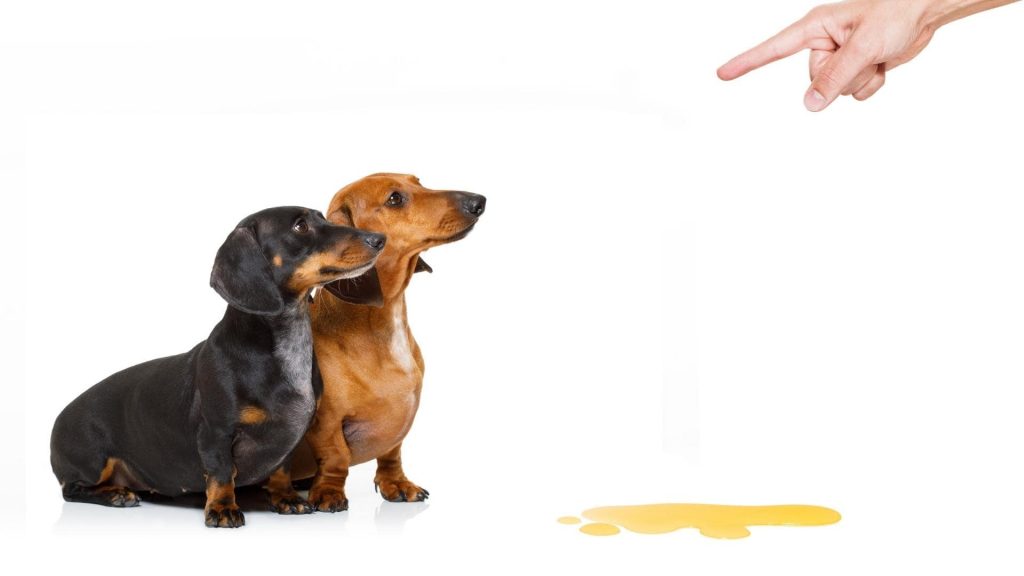
When you punish your dog for peeing in the house it can often make things worse. Take it from their perspective.
They have no idea why you are yelling (especially if there is a time delay) or they may just learn that peeing in front of you is bad.
Now you have a dog that is afraid to pee in front of you so they won’t pee on walks or outside while you watch.
Reward-based training is always the better approach and leads to much better results. Anytime your dog properly goes pee outside, praise them, and reward them.
9.) Water Availability
If your dog is having accidents, taking their water away is not going to solve the issue. You still need to train them or deal with any medical issues should that be the problem.
Water should be available to your pet at all times throughout the day. The only exception is before bed.
You can remove access to water 1-2 hours before bed and make sure you let them out before bed. That way nighttime accidents are less frequent.
Just make sure to give them access again right away in the morning!
10.) Monitor Water Intake
To add to step 8, you should also be watching your dog’s water intake. Some dogs will drink water and immediately need to go out.
Others will drink water and 10-15 minutes later they need to pee. Monitor their water intake and you will begin to know their patterns.
11.) Avoid Pee Pads
Pee pads in the home can sometimes make things worse. When pups start using them reliably, supervision becomes less strict.
When this happens some dogs will often start using other surfaces that look similar to the pee pads.
So do dog pee pads help train your dog?
Generally no. In fact, most of the time they do the opposite and motivate dogs to pee inside more.
So instead of having a dog that goes outside, you have a dog that pees inside and gets confused where they can actually pee.
However, if you are really set on getting them using pee pads try some alternative pee pads that are completely unique to everything in your house.
That will remove any confusion.
12.) Seek Professional Help
If you feel as though you are in over your head, seek professional dog training help. In some cases, you do everything right but there is something else going on you just cannot determine yourself.
An outside perspective from an expert is always the quickest and fastest way to get results. You can either choose an in person dog trainer or pick an online dog training program specific to handling dogs peeing inside.
How To Stop A Male Dog From Peeing On Everything?
The best way to get a male dog to stop peeing on everything and marking their territory is to get them neutered. This will reduce their male sex hormone and help control their urges to pee on everything.
If your dog is already ‘fixed’ and they are still peeing on things, they have likely turned this into a habit.
What Can You Spray To Keep Dogs From Peeing In House?
You can use pet stain and odor removal spray to clean up any pee in your house. This will help eliminate the smell and make it impossible for dogs to locate where they pee. This will help reduce your dog’s peeing in the house.
Here are the best dog pee sprays you can get on Amazon:
- Resolve Urine Destroyer Spray Stain & Odor Remover
- Resolve Ultra Pet Stain & Odor Remover Spray
- Simple Solution Extreme Pet Stain and Odor Remover
Frequently Asked Questions About Dogs Peeing Inside
Why Does My Dog Pee Inside After Being Outside?
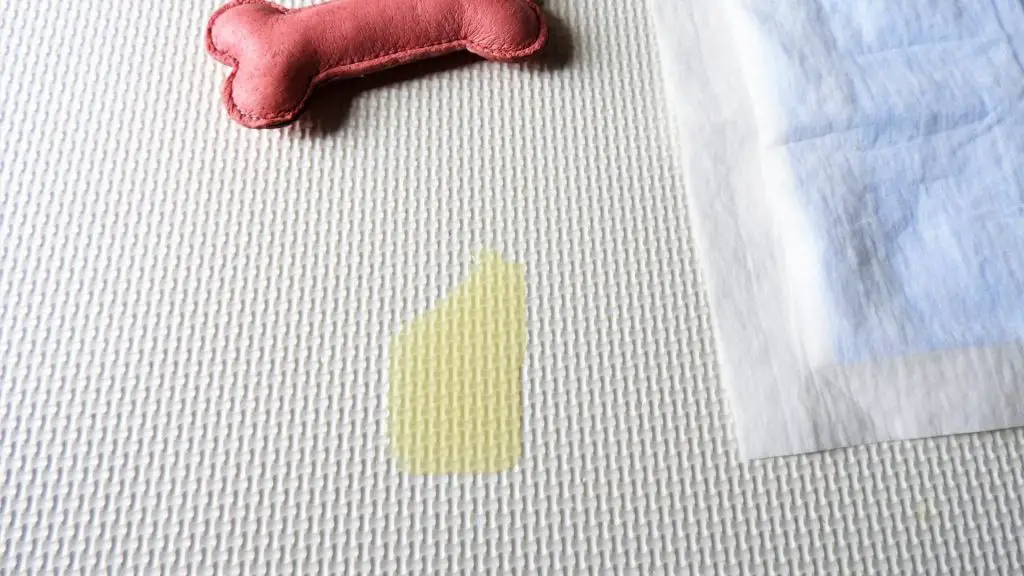
The first question you need to ask yourself is “why does my dog pee inside after being outside?”
There could be a number of reasons for this, so it’s important to try and figure out what the root cause may be. Here are some common reasons why dogs pee in the house after being outside:
- Did have to go while they were outside
- They perfer to relieve themselves on a specific surface inside
- They were not able to find a good spot to relieve themselves
- There was too much traffic or activity outside and they felt nervous
- The weather was too cold, hot, or wet for them to want to stay outside to relieve themselves
What Is The Hardest Dog To House Train?
The hardest dog breeds to house train are ones from the smaller breeds. This is because they have small bladders and need to go more frequently.
Dachshunds have a reputation for being the most difficult to house train. Some other breeds that are hard to house train include:
- Pomeranians
- Bichon Frise
- Jack Russell Terriers
- Afghan Hound
- Dalmatian
- Chow Chow
- Bulldog
- Beagle
Do Dogs Eventually Stop Peeing In The House?
Yes, dogs eventually do stop peeing in the house when they are properly trained. However, when not properly trained dogs can develop preferences to peeing inside, which means training them to pee outside becomes even more difficult.
It’s important to be patient and consistent with your dog when house training them. Never punish your dog for accidents, as this will only make the problem worse.
If you stick to a regular potty schedule and provide plenty of opportunities for your dog to relieve themselves outside, they will eventually learn to hold it until they can go outside.
What Can I Put On The Floor To Stop My Dog From Peeing?
If your dog is peeing inside putting a pad or something on the floor to prevent peeing is not effective. In fact, it can encourage dogs to pee more inside because they think it’s okay to relieve themselves on that surface.
The one thing that you can put on the floor to prevent a dog from peeing inside is urine masking cleaner. This is a cleaner that contains enzymes that break down the urine so it can’t be smelled. Dogs that love to mark their territory with urine will be less likely to do so if they can’t smell their own pee.
Do Dogs Pee In The House For Attention?
Dogs will sometimes pee in the house for attention, but this is usually only done by puppies or young dogs.
If your dog is suddenly urinating inside after previously being house trained it’s important to take them to the vet to rule out any medical causes.
It’s also possible that your dog is urinating inside because they are not getting enough attention from you. In this case, the best thing to do is to give your dog more attention and make sure they are getting plenty of exercise.
Final Thoughts
All in all how to stop a dog from peeing in the house comes down to proper house training and plenty of patience.
There will be accidents, but as long as you are consistent with your dog they will eventually learn to hold it until they can go outside.
If you are having trouble house training your dog, or if they are suddenly urinating inside after being house trained, it’s best to consult with a professional trainer or behaviorist.
I hope you enjoyed this article on how to stop a dog from peeing and pooping in the house.
Citations
How To Stop Your Dog From Peeing In The House
8 Tips To Stop Your Dog From Peeing In The House
Urine-Marking Behavior: How To Prevent It
Why Does My Puppy Pee In The House?
How To Stop Submissive Or Excitement Peeing In Dogs
Dementia And Senility In Dogs
Urinary Incontinence In Dogs
How to Potty Train Puppies: A Comprehensive Guide for Success
